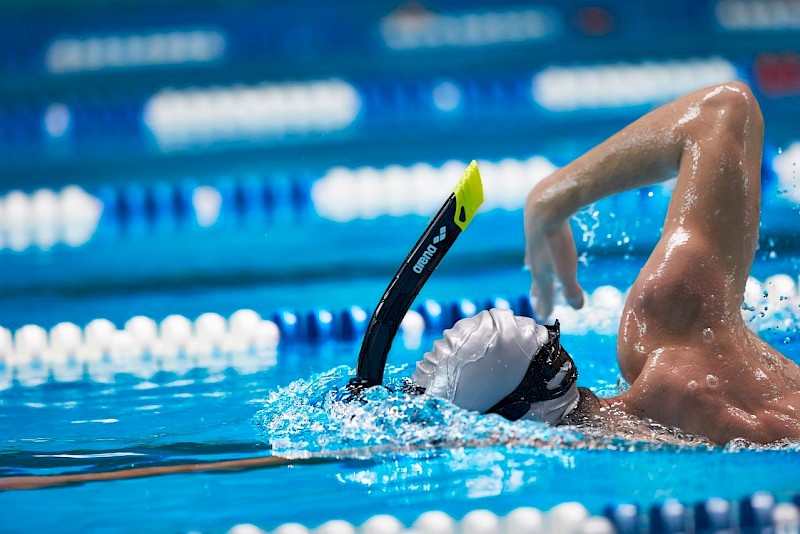Among the wide range of equipment that can be used for training is the front snorkel. It is a piece of equipment whose use is relatively recent and stems from the need to bypass the obstacle of breathing in freestyle and focus on a series of aspects linked to other factors (postural, coordination, balance and weight distribution, etc.) and intervene to correct or perfect them without the rotating movement of the head during breathing interfering with the perception of the movement.

Like all tools, it should be used with well-defined purposes and needs a period of adaptation. If you have never used it before, it may be useful at first to equip yourself with a nose plug to avoid unpleasant nasal washes with every inhalation.
- opportunities of using the mouthpiece
- legwork without a board
- swimming technique exercises
- breathing exercises
- conditional training
Opportunities to use the mouthpiece
Opportunities to use the mouthpiece
Working with legs without a seat
With this swimming apparatus, one can develop leg work that would be difficult with a board, especially for swimming novices. The board in fact needs to be 'tamed', and to do so requires the right guidance (but even with that, the desired result may not be achieved). Without this skill, legwork is likely to be experienced with frustration and associated with unnecessary fatigue, with the final feeling of having only wasted time.
With the snorkel, on the other hand, one can set the correct posture for effective use of the legs: the head, resting on the surface of the water, and the gaze, directed towards the bottom of the pool, allow the pelvis to be lifted, reducing friction as one moves forward.
Practical example: perform short distances using only the legs. Arms are parallel, stretched forward; elbows outstretched and hands positioned approximately 20 cm below the water surface; gaze downwards. As they advance, the legs should break the surface of the water firmly. The coach can influence the effectiveness of the gesture by adjusting the width of the gambit, the distance between the knees and between the toes.
Swimming technique exercises
When using the snorkel, as we do not have to turn our head to breathe, we can focus on the dynamics of the movements and develop technique exercises aimed at coordination.
Practical example: we can set up deprivation and isolation exercises, i.e. work with only one arm at a time, to focus on arm rotation and rolling. By stabilising the waterline with the snorkel (see posture), one can play on the position of the stationary arm (in front or along the body). This allows new skills to be acquired for use in regular two-arm swimming.
Breathing exercises
Breathing is always the most delicate and important aspect to deal with in swimming: the snorkel helps to develop awareness.
Practical example: you can set a continuous breathing rhythm between inhalation and exhalation, with the aim of having no interruptions. If you have a preferred breathing side (e.g. the right side), on the pulling phase of the arm (right arm), perform inhalation while on the pulling phase of the opposite arm (left arm) perform exhalation. The goal is to have the breathing rhythm set the rhythm for the arm pull.
This can be a way of setting the breathing control through awareness. The goal, of course, will then be to apply what has been learnt with this exercise to regular swimming.
Conditional training
The snorkel can also be used in conditional training: by stressing the respiratory muscles, 'vital capacity' will be developed.
Practical example: repetitions over medium-short distances (25 m - 50 m- 75 m) but at high intensity can be tackled. The most suitable styles are freestyle and dolphin, as athletes competing in 50 m tend to minimize breathing, and the snorkel helps to set up posture, frequency and leg-arm coordination.
After a short adaptation period, only imagination can limit the applications of the mouthpiece (here, maybe it is not ideal for supine use: in the back we can have an annoying 'straw effect'). All kidding aside: the mouthpiece represents a tool that can cause conscious addiction, just be increasingly clear about what purpose we want to use it for.
Mauro Lanzoni, ENDU Channel.
